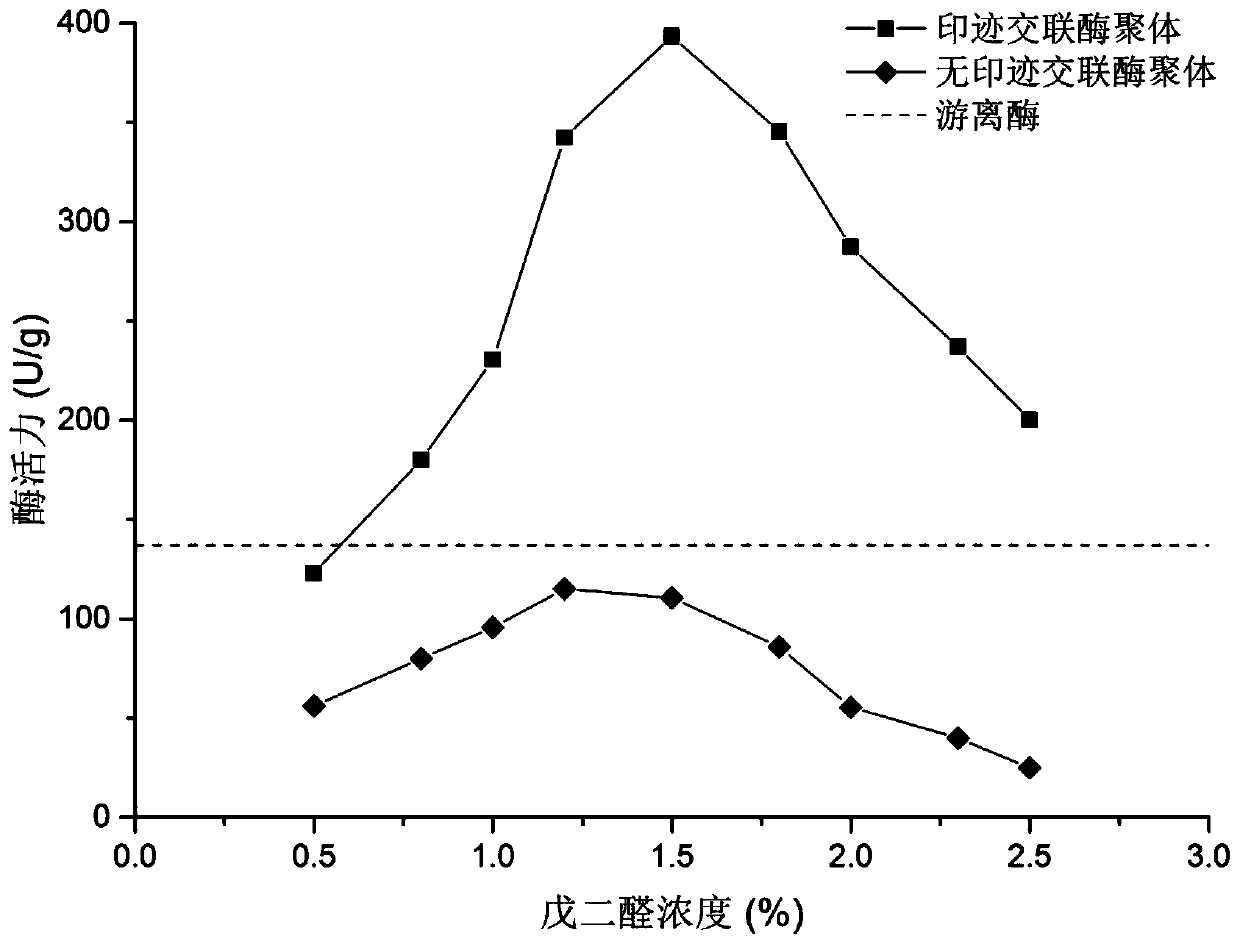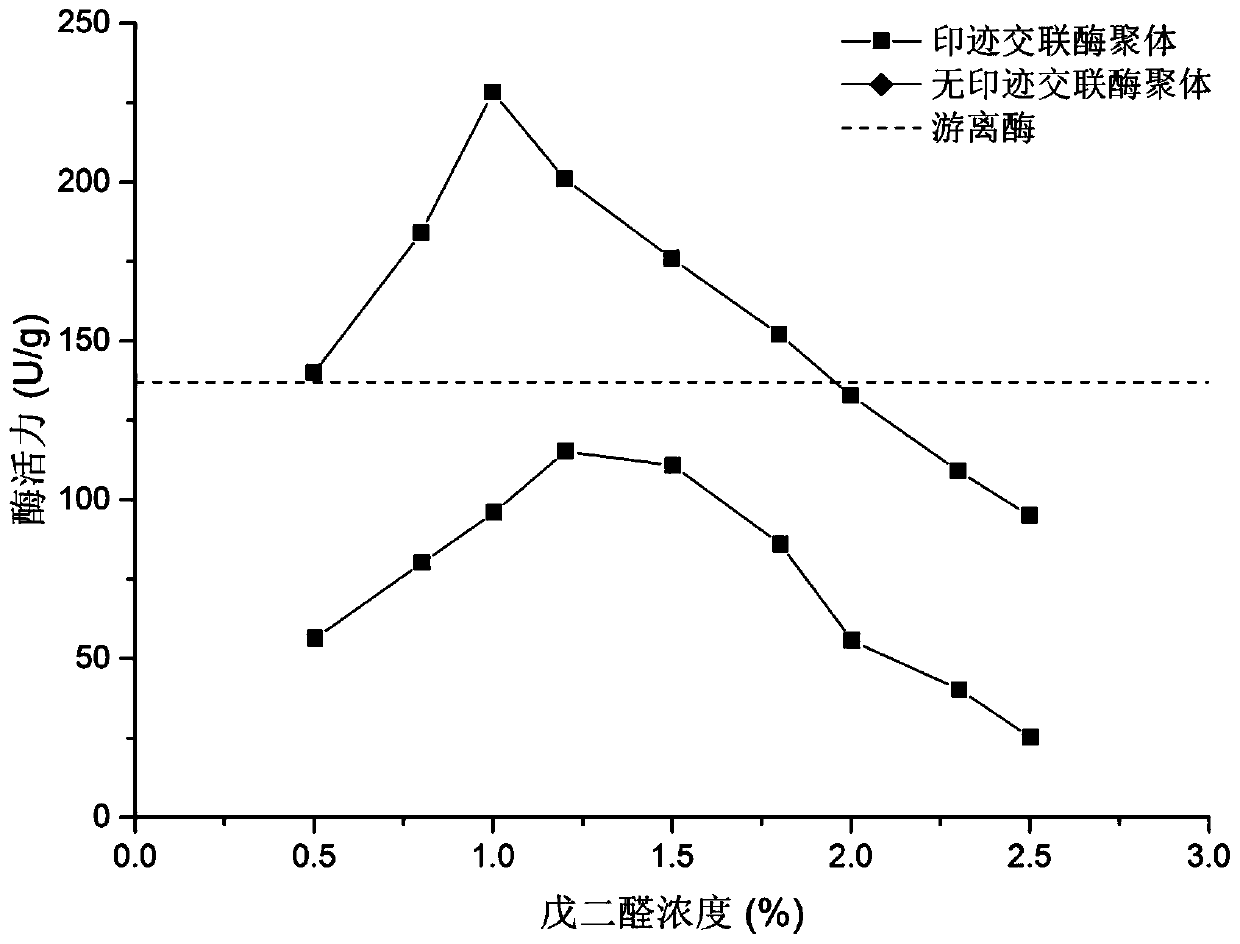A method for immobilizing phospholipase d to improve the activity of phosphatidylglycerol synthesis
A phosphatidylglycerol, synthesis reaction technology, applied in biochemical equipment and methods, immobilized on/in organic carriers, enzymes, etc., can solve problems such as high cost, increase PG production cost, etc., achieve enzyme activity improvement, low Good cost and stability
- Summary
- Abstract
- Description
- Claims
- Application Information
AI Technical Summary
Problems solved by technology
Method used
Image
Examples
Embodiment 1
[0049] This embodiment provides a method for immobilizing phospholipase D to improve the activity of phosphatidylglycerol synthesis. The method is carried out according to the following steps:
[0050] Step 1, blotting of phospholipase D:
[0051] Add 0.05 g of glycerol to 1 mL of acetate buffer (0.2 M, pH 5.5) containing phospholipase D at a concentration of 0.05 mg / mL, and blot for 60 min under gentle stirring in an ice bath to obtain enzyme-substrate complexes. substance (imprinted enzyme) solution.
[0052] Step 2, precipitation of phospholipase D-substrate complex:
[0053] Add 8 mL of supercooled (below 0°C) anhydrous precipitant dropwise to the enzyme-substrate complex solution obtained in step 1 (methanol, ethanol, acetone, propanol and isopropanol were used as precipitants respectively), dropwise After completion, the precipitation was continued for 10 min under gentle stirring in an ice bath to obtain a mixed solution containing phospholipase D-substrate complex ag...
Embodiment 2
[0065] This embodiment provides a method for immobilizing phospholipase D to improve the activity of phosphatidylglycerol synthesis. The method is carried out according to the following steps:
[0066] Step 1, blotting of phospholipase D:
[0067] Same as Step 1 of Example 1.
[0068] Step 2, precipitation of phospholipase D-substrate complex:
[0069] Add 8 mL of supercooled (below 0°C) anhydrous precipitant absolute ethanol dropwise to the enzyme-substrate complex solution obtained in step 1. After the dropwise addition, continue to precipitate under gentle stirring in an ice bath for 10 min to obtain Phospholipase D-substrate complex aggregate mixed solution.
[0070] Step 3, cross-linking of phospholipase D-substrate complex aggregates:
[0071] Under ice-bath conditions, add water-soluble cross-linking agent mass concentration to the mixed solution obtained in step 2 and be 25% glutaraldehyde, adjust the glutaraldehyde mass concentration in the reaction solution to be ...
Embodiment 3
[0081] This embodiment provides a method for immobilizing phospholipase D to improve the activity of phosphatidylglycerol synthesis. The method is carried out according to the following steps:
[0082] Step 1, blotting of phospholipase D:
[0083] Add 0.1 mL of ether solution containing phosphatidylcholine at a concentration of 1 mg / mL to 1 mL of acetate buffer solution containing phospholipase D at a concentration of 0.05 mg / mL (concentration is 0.2 M, pH value is 5.5), under gentle stirring in an ice bath, After blotting for 60 min, a solution containing the enzyme-substrate complex (imprinted enzyme) was obtained.
[0084] Step 2, precipitation of phospholipase D-substrate complex:
[0085] Add 8 mL of supercooled (below 0°C) anhydrous precipitant absolute ethanol dropwise to the enzyme-substrate complex solution obtained in step 1. After the dropwise addition, continue to precipitate under gentle stirring in an ice bath for 10 min to obtain Phospholipase D-substrate comp...
PUM
 Login to View More
Login to View More Abstract
Description
Claims
Application Information
 Login to View More
Login to View More - R&D
- Intellectual Property
- Life Sciences
- Materials
- Tech Scout
- Unparalleled Data Quality
- Higher Quality Content
- 60% Fewer Hallucinations
Browse by: Latest US Patents, China's latest patents, Technical Efficacy Thesaurus, Application Domain, Technology Topic, Popular Technical Reports.
© 2025 PatSnap. All rights reserved.Legal|Privacy policy|Modern Slavery Act Transparency Statement|Sitemap|About US| Contact US: help@patsnap.com



